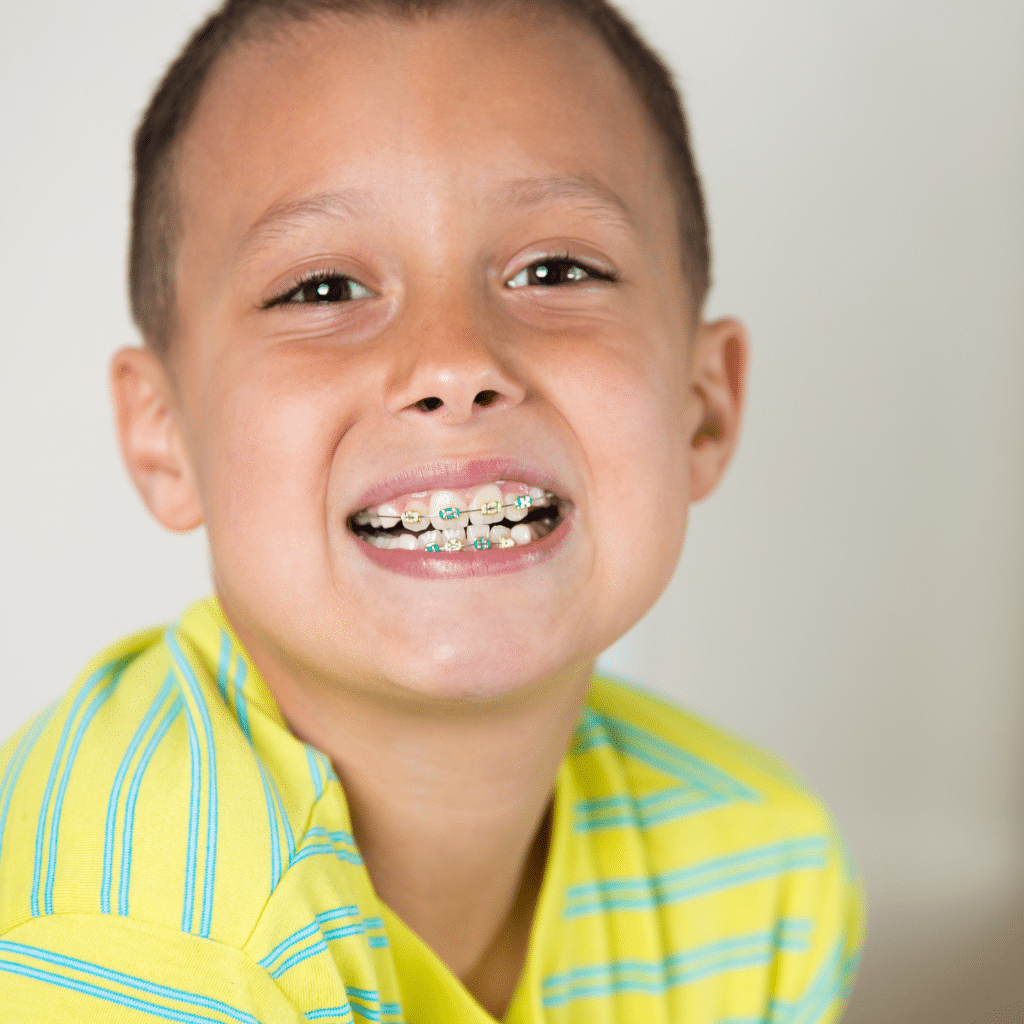The average age for getting braces is between 10 and 14 years, aligning with the development of permanent teeth and the jaw. Experts recommend the first orthodontic evaluation by age 7 to assess individual needs and timing. Signs like misaligned or crowded teeth often necessitate braces, with early intervention being advantageous. For personalised advice on the right time for treatment, consult our dentist to explore the best braces options for your child’s dental needs. Factors like dental development and oral hygiene influence timing. Further insights into ideal orthodontic care await those seeking thorough guidance beyond the basics.
Key Takeaways
- The average age for braces is between 10 and 14 years, aligning with jaw and teeth development.
- An initial orthodontic evaluation is recommended by age 7 to assess potential needs.
- Individual dental development and severity of issues influence the specific timing for braces.
- Early intervention can prevent severe dental problems and improve self-esteem during adolescence.
- Factors influencing the timing include growth spurts, family history, and oral hygiene practices.
When Is the Right Time for Braces? Understanding the Ideal Age to Start Orthodontic Care
Orthodontic care is primarily sought to address malocclusion, misaligned teeth, and jaw irregularities, which can affect oral function and aesthetics.
Most children receive braces between the ages of 9 and 14, although the initial orthodontic evaluation is ideally conducted by age 7 to identify any potential issues early.
Early assessments do not imply immediate treatment but facilitate timely intervention when necessary.
Why Do People Need Braces in the First Place
The necessity for braces often arises from the need to correct dental misalignments and malocclusions, which can affect both function and aesthetics.
Individuals may need braces due to issues such as overcrowded teeth, overbites, underbites, and crossbites. These conditions can impede proper jaw alignment and lead to complications like tooth decay and gum disease.
Orthodontic treatment, guided by an orthodontist, aims to address these issues early, mitigating potential long-term consequences. Early orthodontic treatment can also prevent more severe problems later in life, promoting better oral health.
Braces treatment aligns teeth, ensuring ideal dental function. By intervening at the right time, orthodontists can considerably enhance both the appearance and health of the individual’s dental structure, thereby improving overall quality of life.
At What Age Do Most Children Get Braces
When determining the ideal age for children to receive braces, several factors must be considered, including the stage of dental development and the nature of the orthodontic issues present.
An orthodontic evaluation by age seven is recommended to identify potential issues early. This early intervention allows orthodontists to assess whether a child may need braces or other orthodontic treatments in the future.
Although the best age for braces varies, the average age for children’s braces is typically between 9 and 14 when most permanent teeth have erupted.
The best time to get braces is when the child’s jaw and teeth are still developing, making it easier to correct alignment issues.
Consequently, the age to get braces is dependent on individual dental development and specific orthodontic needs.

What Is the Ideal Age to Visit an Orthodontist for the First Time
Early orthodontic assessments are essential as they allow for the identification of potential issues that may require early treatment. This age is considered the ideal age because it enables the orthodontist to determine the best age to start braces if needed.
An early appointment for your child provides several benefits:
- Detection of developmental issues: Identifying problems early can prevent future complexities.
- Guidance for jaw growth: Early intervention can help guide jaw development effectively.
- Best timing for braces: Establishing the correct age for braces can lead to more efficient treatment outcomes.
Consulting an orthodontist at the recommended age guarantees proactive dental care.
When is the Best Age for a Child to Get Braces?
The American Association of Orthodontists recommends that children receive an initial orthodontic evaluation by age 7, as early detection of potential issues can facilitate timely intervention.
At this stage, the orthodontist can assess the development of the jaw and teeth, determining whether early corrective measures are necessary.
Unlike adult orthodontic treatment, braces for children can be part of a phased approach, addressing growth-related concerns that can be more efficiently resolved during childhood.
Why Age 7 is Important for an Orthodontic Evaluation
Age 7 serves as a pivotal benchmark in orthodontic evaluation, marking the recommended time for a child’s initial appraisal.
At this age, a mix of permanent teeth and baby teeth allows orthodontists to identify potential issues. Early detection facilitates timely orthodontic treatment for your child if needed.
By evaluating dental development at the age of 7, orthodontists can determine if a child may need braces in the future.
- Developmental Indicators: Evaluation of permanent teeth alignment and jaw growth.
- Preventive Measures: Early intervention can address issues before they worsen.
- Strategic Planning: Establishes the best age to get braces and whether kids should get braces sooner or later.
This proactive approach guarantees that a child gets braces at the ideal time, aiding in effective treatment outcomes.
How Braces for Kids Differ from Adult Orthodontic Treatment
Determining the ideal age for braces involves evaluating both developmental readiness and the specific orthodontic needs of the child. Typically, the age to get braces for your child coincides with the emergence of adult teeth, usually between the ages of 9 and 14.
Kids get orthodontic treatment primarily using traditional braces, which include metal braces and clear braces. Clear, removable braces are also an option for specific cases.
In contrast, adults get braces to address more complex misalignments, requiring longer treatment durations. Adult orthodontic treatment often leverages advanced technologies, including clear removable braces, for aesthetic reasons.
Consequently, while the fundamental principles of orthodontics remain constant, the approach for braces in children differs from adults, considering factors like dental development and treatment goals.
What are the Signs a Child May Need Braces?
Identifying early orthodontic issues in children is essential for timely intervention and successful treatment outcomes.
The position and health of baby teeth play a significant role in determining the need for braces, as misalignment or early loss can indicate potential future dental problems.
Consulting with a dentist or orthodontist at the first sign of irregularities allows for early intervention and potentially less invasive treatment options.

Identifying Early Orthodontic Issues in Children
While some children naturally develop straight teeth, others exhibit early signs that may indicate the need for orthodontic intervention. Identifying these early orthodontic issues can help determine the best age for treatment.
Parents should observe:
- Irregular bite patterns: Misalignment or improper bite can indicate that a child needs braces.
- Crowded teeth: Overlapping or crowded teeth suggest that kids require professional evaluation.
- Prolonged thumb-sucking: If the habit persists beyond the age range of 4 to 5 years, it can affect tooth alignment.
It is essential to take your child to an orthodontist to identify issues early. This assessment helps determine the best time to get orthodontic treatment.
Understanding the age at which your child might need braces guarantees timely intervention and optimized results.
The Role of Baby Teeth in Orthodontic Treatment
Early identification of orthodontic issues sets the stage for understanding the role of baby teeth in orthodontic treatment.
At a young age, baby teeth function as placeholders for permanent teeth, influencing alignment and bite. The right age for considering braces varies, but early evaluation can determine if kids need intervention.
Signs a child may require braces include misaligned bites or overcrowded teeth, suggesting the most effective course of action.
If a child needs orthodontic attention, options like traditional or invisible braces are assessed based on age and dental development.
The goal is to make certain that when permanent teeth emerge, they do so in an advantageous position, potentially reducing the need to wear braces later in life, consequently facilitating effective treatment.
Consulting with a Dentist or Orthodontist for Early Intervention
Detecting the signs that a child may need braces involves a methodical assessment by a dentist or orthodontist.
Early intervention is vital to determine the best time for braces, ensuring ideal orthodontic outcomes. By scheduling a consultation, professionals can identify if a child may require orthodontic treatment.
The common age for braces typically ranges between 9 and 14 years, although the age can vary based on individual dental development.
Key indicators that a child may need braces include:
- Misalignment of teeth leads to chewing difficulties.
- Crowded teeth may hinder oral hygiene.
- Jaw misalignment causes discomfort or speech issues.
Determining the maximum benefit from braces depends on timely assessments, emphasizing the importance of professional evaluations to address the need for braces efficiently.
Understanding the Need for Braces and Orthodontics
Orthodontic treatment is often necessitated by common dental issues such as overcrowding, misalignment, and bite irregularities.
Jaw alignment plays a critical role in determining the need for braces, as improper alignment can lead to functional problems and aesthetic concerns.
Additionally, addressing any existing tooth decay is essential prior to initiating orthodontic treatment to guarantee ideal oral health and effective outcomes.
Common Dental Issues That Require Braces
Dental malocclusion, a misalignment of the teeth and bite, is a prevalent issue that often necessitates the use of braces. This condition can manifest in various forms, prompting individuals across different age groups to seek orthodontic solutions.
The age for getting braces can vary, but addressing these common dental issues early can be beneficial. The type of braces selected depends on specific needs and preferences. It’s also important to understand how to care for braces during treatment—what to eat after getting braces can significantly reduce discomfort and protect your dental work.
- Crowded Teeth: Insufficient space in the mouth may cause teeth to overlap, leading to functional and aesthetic concerns.
- Overbite or Underbite: Misalignment of the upper and lower jaws may necessitate braces or other orthodontic interventions.
- Spacing Issues: Gaps between teeth, which may result from tooth loss or natural growth, may need braces to help realign the dental structure.
How Jaw Alignment Affects the Need for Braces
Addressing dental malocclusion often involves examining jaw alignment, a fundamental aspect influencing the necessity for orthodontic treatment, such as braces.
Jaw alignment issues, including overbites, underbites, and crossbites, may require intervention to guarantee proper dental function and aesthetics.
Orthodontists determine the best time for treatment, considering that every child is different. While some kids may require braces as young as around the age of seven, others might benefit from waiting until the child reaches adolescence.
There is no exact age for commencing treatment, but early evaluation helps in planning effective care.
Understanding jaw alignment can help your child achieve ideal results, as braces may be necessary to correct the alignment, contributing to long-term oral health.
The Importance of Addressing Tooth Decay Before Getting Orthodontic Treatment
Before initiating orthodontic treatment, it is essential to address any existing tooth decay to secure the success and longevity of the treatment. Neglecting to do so could result in complications, as braces are available to improve alignment, but underlying dental issues may compromise outcomes.
Whether your child requires braces between 10 and 14 years or adults get braces later in life, managing tooth decay is the best course of action to guarantee effective treatment.
- Prevent further decay: Treating cavities early prevents progression during orthodontic treatment.
- Ensure brace adhesion: Healthy teeth provide a stable surface for braces, guaranteeing effectiveness.
- Optimize oral health: Treating decay early contributes to overall oral health and treatment success.
A good idea to schedule a dental check-up when wondering when kids or adults need braces as well.
Why Adults Get Braces
Adults choose to undergo orthodontic treatment for a variety of reasons, including addressing alignment issues that were not corrected during childhood or the development of new dental problems.
The benefits of adult orthodontics extend beyond aesthetics, as they also contribute to improved oral health and function.
Additionally, advancements in orthodontic technology have led to a wider selection of discreet and efficient braces specifically designed to meet the needs of adult patients.

Understanding the Need for Braces in Adulthood
Why do an increasing number of adults seek orthodontic treatment later in life? Several factors contribute to this trend, including aesthetic considerations, functional improvements, and advancements in orthodontic technology.
Adults often seek orthodontics to address long-standing issues that were not treated in childhood or to correct changes in dental alignment due to aging or tooth loss. Various personal and health-related reasons influence the decision to pursue braces.
- Cosmetic Concerns: Adults may desire a more aesthetically pleasing smile, which can boost confidence and self-esteem.
- Functional Improvements: Correcting bite issues can lead to better oral health, reducing wear on teeth and alleviating jaw pain.
- Technological Advancements: Modern orthodontic solutions, such as clear aligners, provide discreet options that appeal to adult patients.
The Benefits of Orthodontics for Adult Teeth
While orthodontic treatment is often associated with adolescence, its benefits for adult teeth are substantial and multifaceted. Adults undergoing orthodontics can achieve significant improvements in oral health, function, and aesthetics.
Correcting malocclusions and misaligned teeth reduces the risk of periodontal disease by making oral hygiene more effective. Improved alignment also aids in proper mastication and reduces undue stress on temporomandibular joints, mitigating jaw-related discomfort.
Aesthetically, orthodontic correction enhances smile symmetry and facial harmony, contributing to increased self-esteem and professional confidence. In addition, advancements in orthodontic techniques and materials have made treatment more accessible and discreet for adults.
Consequently, orthodontics not only addresses cosmetic concerns but also promotes thorough dental well-being, offering a viable solution for individuals seeking to optimize oral health.
Exploring Different Types of Braces for Adults
Building upon the substantial benefits orthodontics offer to adults, it becomes pertinent to examine the various types of braces available for addressing dental concerns in this age group.
Adults seek orthodontic treatment to correct misaligned teeth, improve oral health, and enhance aesthetic appeal. Multiple types of braces cater to these needs, each offering distinct advantages.
- Traditional Metal Braces: These are robust and effective for complex cases, providing precise tooth movement.
- Ceramic Braces: Made of tooth-colored material, they offer a more discreet appearance while maintaining efficacy.
- Clear Aligners: Custom-made, removable trays that provide an inconspicuous and comfortable option for minor to moderate corrections.
Selecting the appropriate type depends on individual dental requirements, lifestyle, and aesthetic preferences.
Conclusion
In determining the ideal age for orthodontic intervention, the consensus among dental professionals is that initial evaluations should occur by age seven. While the average age for braces is typically between 9 and 14 years, individual needs vary based on dental development and specific orthodontic issues. Recognizing early signs, such as misaligned teeth or bite issues, can guide timely intervention. Additionally, adults increasingly seek orthodontic solutions, driven by advancements in discreet treatment options and the desire for improved oral health and aesthetics.


